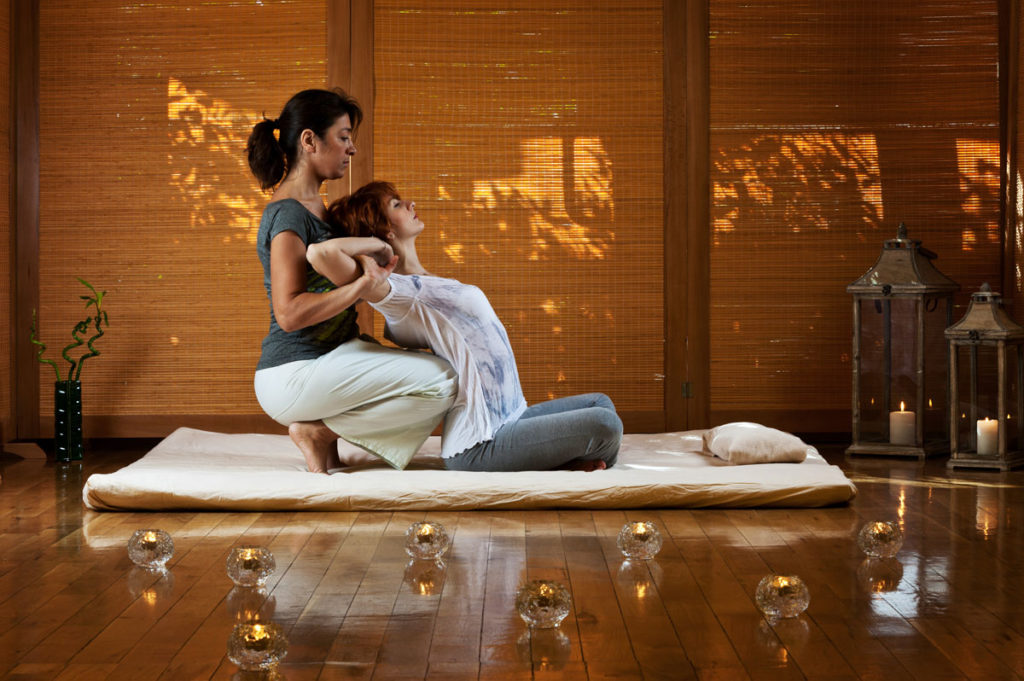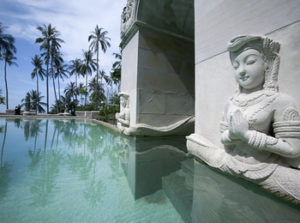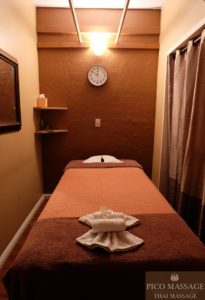Thai Massage: Feels So Good, Works So Well
- Published: Wednesday, May 17th 2017
- in Fitness

Stretching feels good, relieves tension and helps your body stay limber. Being stretched by your instructor after a Pilates or private training session feels even better. But a Thai massage, administered by a trained massage professional, can be the ultimate feel-good experience–and it has a range of benefits from pain relief to reducing muscle tension.
Thai massage in Thailand is considered a medical treatment and requires extensive training. There are numerous training programs around the world but many dedicated therapists travel to Thailand to acquire an authentic knowledge base in this ancient healing technique.
2,000 years and counting
An Indian physician named Shivago Kumar Bhucca, said to be a contemporary of the Buddha, is credited with developing[1] Thai massage over 2,000 years ago to give monks and nuns the flexibility to sit for long hours in meditation. It was considered such a crucial aspect of medical treatment in Thailand that until the early 20th century, the Thai Department of Health included an official massage division. Thai massage is based on using assisted yoga postures, Ayurvedic principals and acupressure to release blockages along ten lines of energy called sen, which are similar to the meridians of traditional Chinese medicine. [2]

What to expect
If you’re having a Thai massage at a day spa or massage center like Eastside Massage Therapy in New York City or a getaway spa such as Kamalaya Koh Samui, Wellness Sanctuary & Holistic Spa or Tao Garden Health Resort & Spa in Thailand, your massage will probably be administered in a private room.
Traditional Thai massage studios, including many found in the U.S. and UK, are typically equipped with a series of comfortable floor mats (or tables), separated by curtains. The space is private and extremely quiet, and you will be dressed in loose-fitting clothing, often a tee shirt and pants supplied by the spa.
Your therapist will begin by lightly stretching your arms and legs, gradually using her body to increase the stretch. For example, she may kneel on the back of your legs and pull your arms to arch your back and open your chest, or place her shoulder under your heel to lift your leg and stretch your hamstring. Everything is done to enhance the therapeutic benefits and should not be painful.
How it works
Thai massage isn’t just pressure applied to your body by someone else; it balances the body by limbering joints and loosening muscles through movement and strategic pressure. A Spafinder editor said the therapist used her entire body as ballast, slowly easing her into familiar yoga positions like the “bridge” (a backward arch) for a deep and pleasurable stretch. She felt taller and lighter when the session was over – and energized, not sleepy.
The acupressure techniques also release nerve tension, freeing energy flow and releasing emotional tension held within the body.
For the guys in your life
Many men prefer Thai massage because they can be clothed during the session and there isn’t all that touching and rubbing. According to fitness experts, Thai massage can be beneficial to athletes (until recently, there chiropractors did not exist in Thailand and Thai massage was the preferred option for preventing and remedying pain and injuries). In a nutshell, Thai massage is said to: reduce muscle tension and spasms; mobilize the joints; improve blood circulation; balance and increase energy; and treat sciatica, headaches and neck pain.[3]

Where to find it
Thai massage studios are easily found across the U.S., especially in major cities like LA, New York, and San Francisco, and are frequented by in-the-know massage enthusiasts who like the results and the affordable prices. (At Pico Massage in LA, a one-hour massage can be as low as $39.)
You might also enjoy: Spafinder’s Complete Guide to Thai Massage.
[1] Encyclopedia.com, “Gale Encyclopedia of Alternative Medicine,” 2005
[2] Wikapedia
[3] SportsInjury.net, “Thai massage for athletes”



